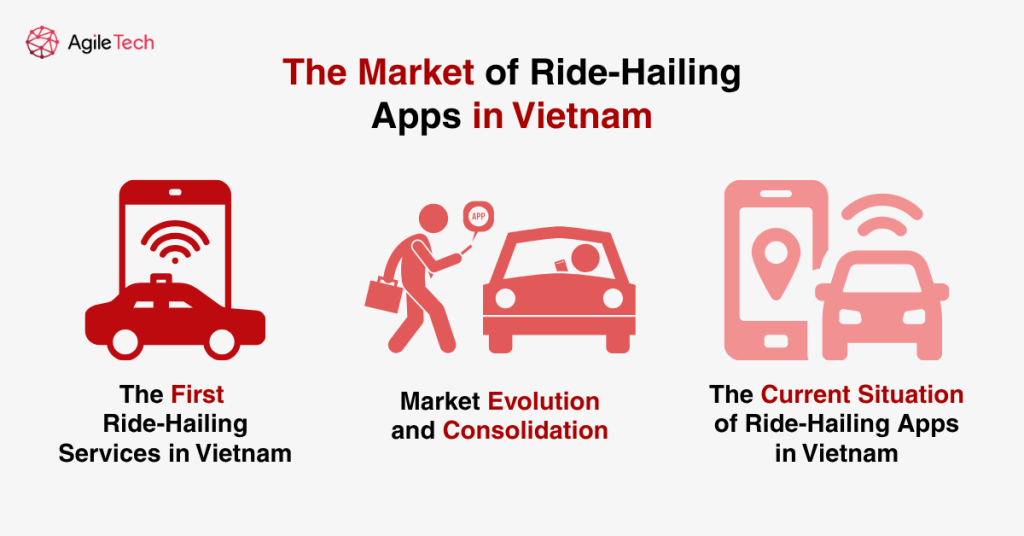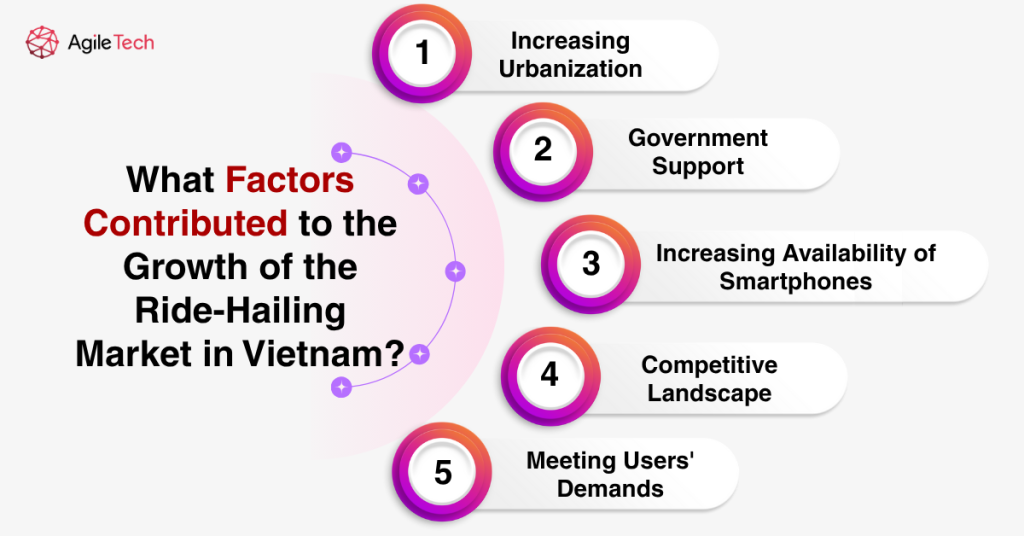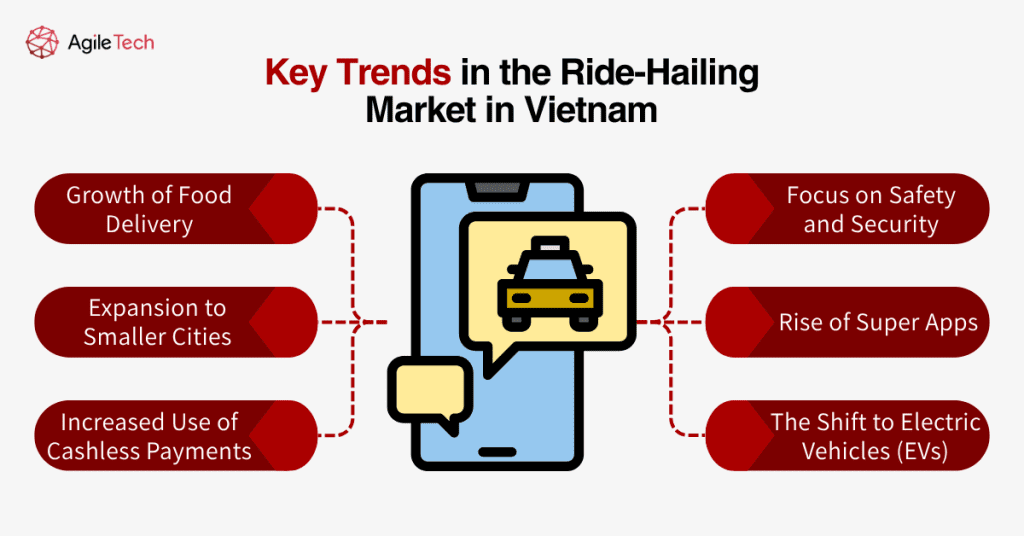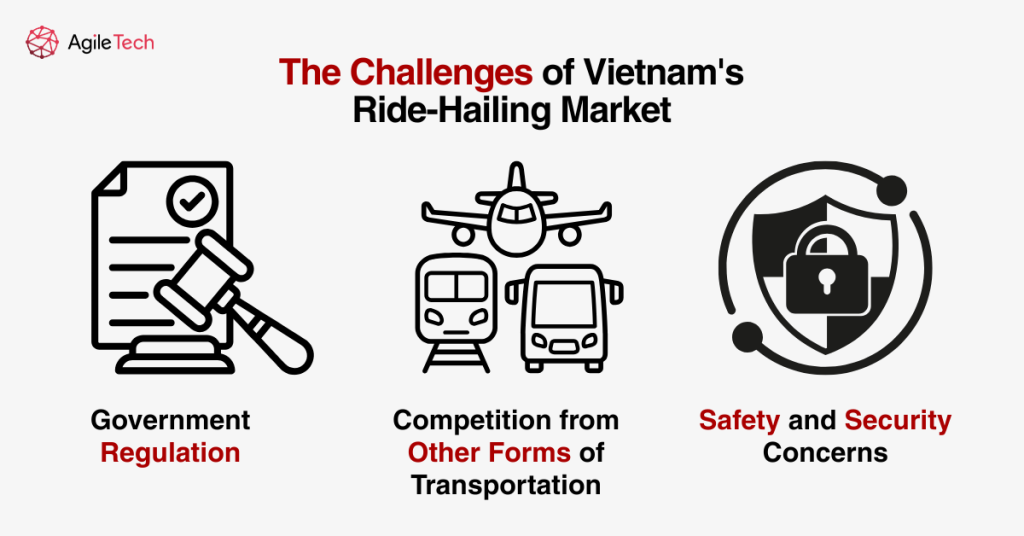Vietnam Ride-Hailing App Market in 2025: Navigating Growth and Competition
Vietnam’s ride-hailing market experienced a dramatic transformation in 2025, marking one of the most significant shifts in Southeast Asia’s transportation landscape. With electric vehicles leading the charge and domestic players challenging international giants, the industry is witnessing unprecedented growth and innovation. The market size is expected to reach USD 1.05 billion in 2025 and grow at a CAGR of 19.5% to reach USD 2.56 billion by 2030.

1. What is a Ride-Hailing App?
A ride-hailing app is a digital platform that connects passengers with drivers through smartphone technology, enabling on-demand transportation services. These applications have revolutionized urban mobility by providing convenient, affordable, and accessible transportation alternatives to traditional taxis and public transport.

1.1. How to use a Ride-Hailing App?
Using a ride-hailing app follows a straightforward process:
- Download and Registration: Users download the app and create an account with personal information and payment methods
- Location Setting: The app uses GPS to determine the user’s current location
- Destination Input: Users enter their desired destination
- Driver Matching: The algorithm matches users with nearby available drivers
- Real-time Tracking: Users can track their driver’s location and estimated arrival time
- Payment Processing: Automatic payment through the app upon trip completion
- Rating System: Both drivers and passengers rate each other to maintain service quality
1.2. Advantages of Ride-Hailing Apps
The popularity of ride-hailing apps stems from numerous benefits they offer to users:
Convenience and Accessibility: Available 24/7 with just a few taps on a smartphone, eliminating the need to search for taxis or navigate public transport schedules.
Transparent Pricing: Upfront fare estimates and cashless transactions reduce pricing disputes and eliminate the need for cash handling.
Safety Features: GPS tracking, driver verification, and rating systems enhance passenger safety and accountability.
Time Efficiency: Reduced waiting times compared to traditional taxis, especially during peak hours or in less accessible areas.
Service Variety: Multiple vehicle options from economy to premium services, accommodating different budget preferences and group sizes.
2. The Market of Ride-Hailing Apps in Vietnam

2.1. The First Ride-Hailing Services in Vietnam
Vietnam’s ride-hailing app market has been at the forefront of the country’s digital transformation. The revolution began in the mid-2010s when international platforms recognized Vietnam’s enormous potential. GrabTaxi (now Grab) pioneered the ride-hailing app market in 2014, launching operations in Ho Chi Minh City and Hanoi. Uber followed in 2015, sparking intense competition that accelerated innovation, market expansion, and user adoption.
These early ride-hailing apps transformed urban transportation in Vietnam’s major cities, introducing millions of users to convenient, app-based mobility services. Traditional taxi companies were forced to innovate and digitize, while entirely new business models emerged around the gig economy, creating employment opportunities for thousands of local drivers.
As the ride-hailing app market continued to grow, local entrepreneurs identified opportunities to build Vietnamese alternatives that catered to local preferences and cultural nuances. Be Group, launched in 2018, became the first major homegrown competitor, positioning itself as a trusted, Vietnamese-built alternative to international ride-hailing giants.v
2.2. The Rise of Electric Transportation
The most significant transformation in Vietnam’s ride-hailing market came with the introduction of electric vehicle-focused platforms. Xanh SM, operated by Vingroup’s GSM company, launched its all-electric taxi service and quickly disrupted the established market dynamics.
According to Bloomberg Businessweek Vietnam, after a year of operation, Xanh SM boasts 27,000 electric cars with plans to increase this number to 50,000 within two years. The company has also formed strategic partnerships with major brands and expanded its presence across Vietnam.
2.3. The Current Market Leadership in 2025
The Vietnamese ride-hailing market in 2025 presents a completely transformed competitive landscape, with electric vehicle platforms leading the revolution:
Xanh SM: According to the latest report from Mordor Intelligence, Xanh SM maintains its leading position in the Vietnamese taxi & technology taxi market in Q1 2025 with 39.85% market share, establishing itself as the undisputed market leader. Customer satisfaction with Xanh SM electric car service reached 83%, surpassing competitors, with 84% of customers willing to recommend the service.
Grab: Grab holds second position with 35.57% market share, though the platform is under significant pressure as its market share continues to shrink against local competitors. Recent research indicates that 54-55% of Vietnamese customers are still using Grab, showing the platform maintains a loyal user base despite increased competition.
Be: Vietnam’s homegrown champion maintains its position as a strong local alternative, though facing intensified competition from the electric vehicle revolution. The platform continues to appeal to users who prefer supporting domestic brands and appreciate local customer service approaches.
The market transformation reflects Vietnamese consumers’ growing preference for sustainable transportation options and their embrace of electric vehicle technology. The ride-hailing sector is projected to achieve a compound annual growth rate (CAGR) of 22.7% between 2025 and 2030, significantly outpacing previous growth rates.
3. What Factors Contributed to the Growth of the Ride-Hailing Market in Vietnam?

3.1. Increasing Urbanization
Vietnam’s rapid urbanization continues to drive ride-hailing adoption. With over 38% of the population now living in urban areas, cities like Ho Chi Minh City and Hanoi face mounting transportation challenges. Traditional public transport systems struggle to keep pace with urban expansion, creating opportunities for flexible ride-hailing solutions.
The urban population is projected to reach 50% by 2030, further expanding the addressable market. New urban developments often lack comprehensive public transport infrastructure, making ride-hailing an essential mobility solution for residents.
3.2. Increasing Availability of Smartphones
Vietnam’s smartphone penetration has reached over 75% of the population in 2025, providing the technological foundation for widespread ride-hailing adoption. The availability of affordable smartphones and robust internet infrastructure has made digital transportation services accessible to broader demographics across all income levels.
The nationwide deployment of 4G networks and accelerating 5G rollout enhance app performance, real-time tracking accuracy, and overall user experience, enabling more sophisticated features and services.
3.3. Government Support
The Vietnamese government has implemented increasingly supportive policies for the digital economy, including ride-hailing services. Key initiatives include:
- Digital Economy Strategy: National commitment to digital transformation across all sectors
- Electric Vehicle Incentives: Tax benefits and subsidies supporting the transition to electric transportation
- Smart City Development: Integration of ride-hailing data into urban planning and traffic management systems
- Regulatory Clarity: Streamlined licensing requirements and operational guidelines for ride-hailing platforms
3.4. Competitive Landscape
Intense competition has driven continuous innovation and service improvement across the market. Companies compete through:
- Technology Innovation: Advanced algorithms for route optimization and driver-passenger matching
- Service Quality: Enhanced customer experience through improved app interfaces and support systems
- Sustainability Focus: Electric vehicle adoption and environmental responsibility initiatives
- Pricing Strategy: Competitive fare structures and targeted promotional campaigns
3.5. Meeting Users’ Demands
Ride-hailing services have successfully addressed specific transportation needs in Vietnam:
- Environmental Consciousness: Electric vehicle options align with growing environmental awareness
- Traffic Solutions: Efficient routing and real-time traffic updates help navigate congested urban areas
- Safety and Comfort: Professional drivers and well-maintained vehicles provide superior service quality
- Weather Reliability: Dependable transportation during Vietnam’s challenging weather conditions
4. Key Trends in the Ride-Hailing Market in Vietnam

4.1. Growth of Food Delivery
The integration of food delivery services has become crucial for revenue diversification. Major platforms have expanded beyond transportation to capture the growing food delivery market, which continues to experience strong growth in 2025.
This trend reflects the evolution toward comprehensive lifestyle platforms, where ride-hailing serves as the foundation for broader service ecosystems including food delivery, package delivery, and financial services.
4.2. Expansion to Smaller Cities
While major cities remain primary markets, ride-hailing services are increasingly penetrating tier-2 and tier-3 cities throughout Vietnam. Xanh SM’s pure electric taxis are now present in 35 provinces and cities across Vietnam. This expansion is driven by:
- Improved Digital Infrastructure: Enhanced internet connectivity in smaller urban centers
- Economic Development: Rising disposable income in secondary cities
- Tourism Growth: Increasing domestic and international tourism demand
- Limited Transportation Options: Insufficient public transportation in smaller cities
4.3. Increased Use of Cashless Payments
Digital payment adoption has accelerated significantly in 2025. Key developments include:
- E-wallet Integration: Seamless integration with popular Vietnamese e-wallets
- QR Code Payments: Simplified payment processes through QR code technology
- Bank Integration: Direct connectivity with major Vietnamese banking systems
- Government Digitization: National initiatives promoting cashless society adoption
4.4. Focus on Safety and Security
Enhanced safety measures have become critical differentiators:
- Comprehensive Driver Screening: Rigorous background checks and verification processes
- Real-time Monitoring: Advanced GPS tracking and emergency response systems
- Insurance Coverage: Comprehensive protection for passengers and drivers
- In-app Safety Features: Panic buttons, trip sharing, and driver verification systems
4.5. Rise of Super Apps
The transformation from transportation-only to multi-service platforms represents a significant trend:
- Financial Services: Mobile payments, lending, and insurance products
- Logistics Solutions: Package delivery and courier services
- Lifestyle Integration: Restaurant reservations, event booking, and shopping services
- Business Services: Corporate travel solutions and fleet management
4.6. The Shift to Electric Vehicles (EVs)
The electric vehicle revolution has become the defining trend of 2025:
- Market Leadership: Electric vehicle platforms now dominate market share
- Environmental Impact: Significant reduction in transportation-related emissions
- Cost Efficiency: Lower operational costs benefit both drivers and passengers
- Technology Innovation: Advanced electric vehicle features enhancing user experience
- Government Support: Strong policy backing for electric vehicle adoption
5. The Challenges of Vietnam’s Ride-Hailing Market

5.1. Government Regulation
The regulatory landscape continues to evolve with new challenges:
- Stricter Licensing and Tax Policies: New compliance measures in 2025 could increase operational costs with higher tax obligations and stricter driver background checks
- Data Privacy Compliance: Enhanced requirements for user data protection and privacy
- Electric Vehicle Standards: New regulations governing electric vehicle safety and maintenance
- Platform Accountability: Increased responsibility for service quality and driver management
5.2. Competition from Other Forms of Transportation
Traditional transportation methods continue to compete:
- Motorcycle Taxis: Remain popular for short distances and narrow street access
- Public Transport Investment: Government expansion of bus rapid transit and metro systems
- Personal Vehicle Ownership: Growing motorcycle and car ownership among middle-class consumers
- Traditional Taxi Services: Established operators adapting with their own mobile applications
5.3. Safety and Security Concerns
Despite improvements, safety challenges persist:
- Driver Quality Control: Ensuring consistent service standards across large driver networks
- Vehicle Maintenance: Maintaining safety standards for electric and traditional vehicles
- Data Security: Protecting user information and payment data from cyber threats
- Emergency Response: Developing effective protocols for safety incidents and emergencies
Conclusion
Vietnam’s ride-hailing app market in 2025 represents a revolutionary transformation driven by electric vehicle adoption and domestic innovation. Xanh SM’s market leadership, holding 39.85% market share, highlights the growing success of sustainable ride-hailing solutions and local entrepreneurship.
The ride-hailing market is projected to expand from USD 1.05 billion to USD 2.56 billion by 2030, with a 22.7% CAGR growth rate, underscoring its critical role in shaping Vietnam’s urban mobility future. The electric vehicle revolution has not only redefined transportation efficiency but also positioned Vietnam as a regional leader in sustainable urban mobility and eco-friendly ride-hailing app development.
Achieving long-term success in this dynamic market will require ongoing innovation in EV-powered ride-hailing apps, expansion into underserved areas, and adaptability to evolving mobility regulations. As Vietnam continues to advance its digital transformation and green transportation goals, ride-hailing apps will remain key drivers of both economic growth and environmental progress.
